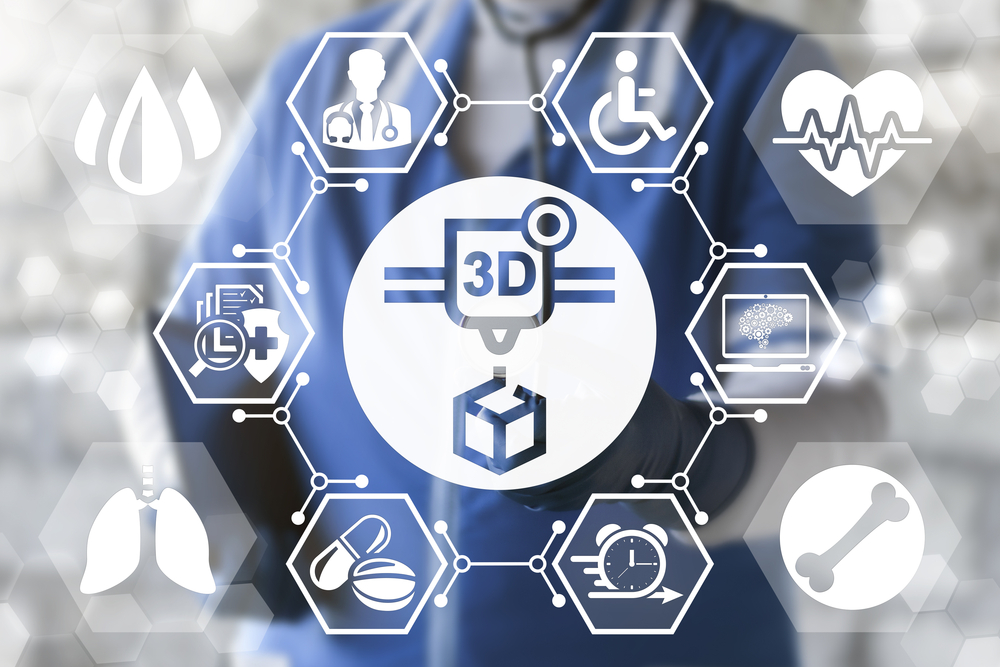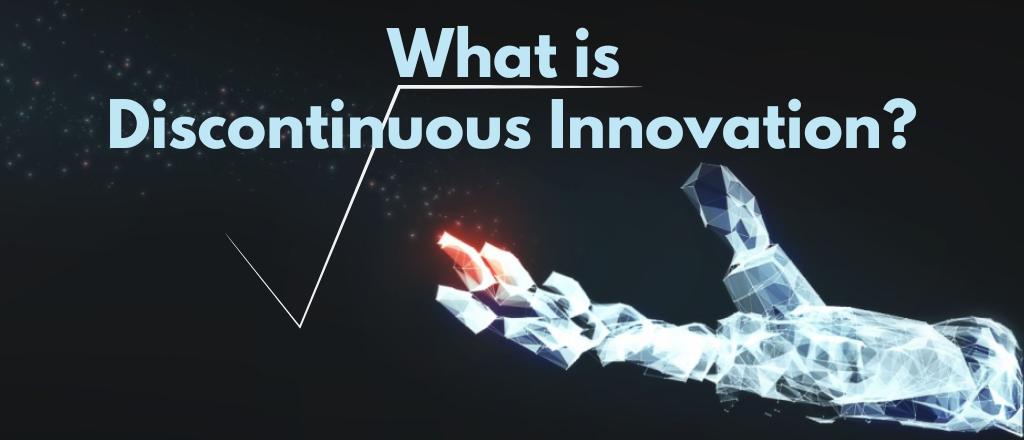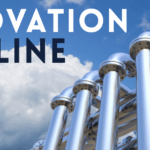What is Discontinuous Innovation?
An innovative product, service, or process that dramatically transforms an existing market by introducing a groundbreaking concept or technology. This often leads to the creation of entirely new markets and fundamentally changes the way consumers engage with a product or service, marking a significant evolution in the industry.
Innovation Strategy is the foundation for company growth and adaptability in the ever-changing environment that is business today. Innovators must conceive their innovation strategy around their business objectives and incorporate both Continuous and Discontinuous Innovation.
Discontinuous Innovations introduce significant technological changes or leaps and can establish entirely new business models or markets. Think of Electric Vehicles or Streaming Platforms.
Discontinuous Innovation is also used interchangeably with “radical” or “disruptive” innovation. However, there are important distinctions worth noting:
Discontinuous Innovation refers to the introduction of something entirely new—a true game-changer that transforms how we live or work. These innovations don’t just improve on existing technologies; they create brand new markets or fundamentally shift consumer behavior. Think of the arrival of the first automobile, the invention of the internet, or the telephone. Each of these breakthroughs didn’t just tweak existing solutions—they ushered in entirely new ways of living and interacting.
Disruptive Innovation, on the other hand, typically starts small. It often enters the market as a simpler, more affordable alternative to established products or services. While it may not initially meet all the needs of mainstream customers, it gradually improves over time, eventually overtaking established competitors. Classic examples include budget airlines or digital cameras, which started out appealing to specific segments before eventually redefining their industries.
In essence, while the terms are sometimes used interchangeably, discontinuous innovation represents a leap—a dramatic and fundamental shift—whereas disruptive innovation is more about starting simple and evolving to dominate. Both, however, are powerful forces reshaping industries and consumer expectations.
Continuous Innovation, in contrast, involves small, consistent, and incremental enhancements to products or services. Think of it like modern evolution vs the Cambrian Big Bang.
Incremental vs. Discontinuous Innovation
Let’s break down the distinctions:
- Incremental Innovation: This is all about gradual, continuous improvement. Imagine a smartphone receiving a slightly better camera or a more efficient battery with each new model—familiar, comfortable, and evolutionary.
- Discontinuous Innovation: Here, we’re talking about a radical leap forward—introducing entirely new concepts or technologies that redefine how we live, work, or play. Electric vehicles didn’t just improve on gas-powered cars; they changed the entire ecosystem. Streaming platforms didn’t just tweak how we watch TV; they fundamentally altered the entertainment landscape.
Dynamically Continuous Innovation: The Middle Ground
There’s also a middle path: dynamically continuous innovation. These innovations bring significant improvements that may not create brand new markets, but they do shift how we use products or services. Consider the transition from film cameras to digital cameras—a substantial shift that didn’t reinvent photography, but certainly revolutionized how we capture and share memories.
Understanding these differences is crucial for crafting effective innovation strategies and recognizing opportunities that could either improve what already exists or disrupt the status quo entirely.
Understanding the Innovator’s Dilemma
A core challenge associated with discontinuous innovation is known as the “innovator’s dilemma.” This refers to the predicament established companies face when groundbreaking innovations threaten to upend their existing business models.
Typically, large organizations are laser-focused on improving their current products and meeting the needs of their loyal, high-value customers. While this approach often delivers steady profits, it can blind companies to radical breakthroughs emerging on the horizon. As a result, big players may hesitate to invest in revolutionary ideas that don’t fit their traditional framework.
Why does this matter? Because disruptive new entrants—unburdened by legacy systems or entrenched customer bases—can seize the opportunity to experiment with transformative technologies or bold business models. The iteration of streaming platforms overtaking cable TV, or digital cameras swiftly replacing film, are prime examples of incumbents being caught off guard by a refusal to embrace discontinuous innovation early on.
In essence, the innovator’s dilemma highlights the struggle for established firms to balance current success with the risk (and promise) of reinventing themselves when discontinuous innovation knocks on the door.
Case Study in Discontinuous Innovation
The On-Demand entertainment era was pioneered by the rule-breaking, opportunistic streaming giant Netflix. Founded in 1997 by Reed Hastings and Marc Randolph, the duo had a vision to give customers convenient access to movies with no late fees. Moving from the DVD-by-mail service to streaming in 2007 marked a pivotal moment in the streaming giant’s history. Netflix began unsettling traditional television networks, not least by their move to producing hugely successful original content, like the award-winning House of Cards political drama series.

Thus the “Netflix Effect” was born, revolutionizing the way we watch movies and TV and disrupting the entire entertainment industry. Netflix is credited with pioneering binge-watching, challenging traditional networks with unlimited options and ad-free watching. Algorithms tailor your personal viewing experience, providing the streaming service with data to analyze trends and viewing patterns – driving their content creation investment. Netflix created an entirely new entertainment model and is a textbook example of Discontinuous Innovation.
When my middle schooler came home with a 3-D printed Star Wars model from Bolts and Bytes camp a few summers back I was suitably impressed but had no concept of the revolutionary effect that 3-D printing was going to have on the world. Never before have we been able to so easily and quickly replicate physical objects.
While 3D printing has many potential applications including apparel, manufacture of hard-to-find parts, and construction, it is the healthcare field that I am most excited about. 3D-printed personalized organs, skin grafts targeted nanoparticles, and medicine designed to individuals’ specific biological needs will revolutionize personal healthcare. Countless lives will be saved by recreating anatomical structures within cell cultures, mimicking the growth of human organs, and eliminating the need to wait for suitable human organ donors.
Challenging Industry Assumptions: The Key to Breakthroughs
True innovation often begins by asking the questions others won’t. Industry assumptions—those long-held beliefs about “the way things are done”—can act like invisible walls, limiting what’s possible. When companies or individuals dare to challenge these assumptions, whole new avenues of discovery open up.
Take, for example, the story of the smartphone. For years, it was assumed that phones needed physical keyboards—until Apple decided to bet on touchscreens, utterly redefining what a phone could be. Or consider Tesla: the automotive world clung to the “truth” that electric vehicles couldn’t compete with gas-powered cars. By flipping the script, Tesla set off a chain reaction in car design, infrastructure, and consumer expectations.
By questioning industry “rules,” innovators can:
- Identify blind spots and overlooked needs.
- Imagine solutions that leapfrog existing technologies.
- Carve out entirely new markets by rewriting what’s possible.
In short, challenging assumptions isn’t just about being contrarian; it’s about clearing space for real breakthroughs—whether you’re designing the next bingeable series, rethinking organ donation, or dreaming up tomorrow’s supply chain.
E-commerce: A Textbook Discontinuous Innovation
If ever there was a modern marketplace upheaval, it’s the shift brought on by e-commerce. For decades, shopping meant heading to the local mall, meandering through aisles under fluorescent lights, and racing the clock to avoid “closing soon” announcements. Then came the digital turn: suddenly, goods and services were available at the click of a button, 24/7, from the comfort of your kitchen table.
E-commerce rewrote the rules entirely. Customers were no longer restricted by geography or store inventory—they had access to global options and endless varieties, not to mention the ability to compare prices, read peer reviews, and have products delivered straight to their doorstep.
The aftershocks? Many main-street retailers struggled to keep pace. The retail landscape morphed dramatically, with online shopping quickly becoming a new norm. Our buying habits transformed: spontaneous midnight shopping sprees, flash sales, and personalized recommendations shaped by our browsing history—all made possible because e-commerce didn’t just tweak old shopping habits; it reimagined them entirely.
In the storybook of discontinuous innovation, e-commerce stands proudly alongside streaming and 3D printing—proof positive that a single technological leap can upend industries and redefine what consumers expect.
Landlines to Mobile Phones: A Textbook Discontinuous Innovation
Another powerful example of discontinuous innovation is the transformation of telecommunication, moving from the era of fixed landline phones to the era of mobile connectivity. For decades, making a phone call meant being anchored to a desk or kitchen wall, the spiral cord acting as a leash to one’s immediate surroundings. Your reach extended as far as the telephone wire would allow.
Then came mobile phones, and with them, a radical shift: suddenly, our conversations were not tethered to a place but could happen anywhere—at the grocery store, on a hiking trail, or halfway across the world. This leap didn’t just make communication more convenient; it fundamentally rewired our relationship with information and each other.
Here’s how this innovation broke the mold:
- Liberated Communication: No longer dependent on physical infrastructure or location, people could connect at all times, regardless of where they were.
- Created Entirely New Behaviors: Think texting friends from the backseat on a school trip, or closing business deals at airport lounges—scenarios unheard of in the age of rotary dials.
- Paved the Way for Future Tech: Out of this disruption grew smartphones, pocket-sized hubs for email, entertainment, photography, and navigation—functions entire industries had once claimed for themselves.
This transformation didn’t just improve the telephone; it reinvented what it meant to communicate, and set the stage for a mobile-centric world.
From Carriages to Cars: A Classic Leap in Discontinuous Innovation
Consider the seismic shift from horse-drawn carriages to the age of the automobile—a prime illustration of discontinuous innovation rewriting the rules. For generations, travel meant hoofbeats, harnesses, and the reliable but limited speed of horse power. The world was arranged around this reality, with bustling carriage works, blacksmiths, and livery stables on every corner.
Then came the internal combustion engine, ushering in a revolution no one saw galloping over the horizon. Early auto makers like Ford and Benz didn’t just build a better carriage—they invented a radical new replacement that left the old infrastructure in the dust. This wasn’t just an incremental improvement; it was the technology equivalent of a zero-to-sixty acceleration. In a remarkably short time, city streets swapped manure for motor oil, travel times shrank, and entire industries—everything from horse feed suppliers to carriage craftsmen—had to reinvent themselves or risk obsolescence.
What followed? The birth of highways, the rise of suburbs, and a transformation of daily life on a scale comparable to today’s streaming-media revolution. The car carved out not just new roads, but an entirely new model of living—classic discontinuous innovation in action.
Disruptive Innovation – 3D Printing
3D printing is changing the way business works, creating radical cost reductions in areas such as molding and tooling, eliminating barriers to entry which can disrupt industries where some companies have traditionally held an advantage. 3D printing reduces the reliance on global supply chains, minimizing lead times and logistics costs. This decentralization allows companies to produce closer to the point of consumption, creating opportunities for KANBAN and other inventory optimization strategies. Traditional manufacturing relies on standardization while 3D printing allows for mass customization – products tailored to customer specifications without significant cost. Hyper-personalization disrupts many sectors creating unique products and designs for customers.

3D printing technology is also driving sustainability in industry increasingly focused on additive processes to minimize waste. As businesses continue to adopt and adapt to this technology, we can expect to see even more transformative impacts across various sectors. For an in-depth look into the effect of additive manufacturing in CPG, Energy, and New Materials take a look at our article on 3D Printing.
Navigating the Hurdles of Discontinuous Innovation
Of course, blazing new trails rarely comes without obstacles. Discontinuous innovation, as thrilling as it is, presents a few formidable challenges along the way:
- Leaping into the Unknown: Charting a new path is inherently risky. Organizations pursuing discontinuous innovation often step into areas with very few roadmaps—or none at all. Success isn’t guaranteed, and there’s always the possibility of costly detours.
- Deep Pockets and Patience Required: Unlike incremental tweaks, game-changing innovations generally demand significant upfront investment—of both time and resources. It’s rarely an overnight endeavor, and often requires long-term financial commitment before seeing a meaningful return.
- Overcoming Cultural Gravity: Established businesses sometimes find their own inertia working against them. Pushing a bold new idea requires upending old habits, facing resistance from within, and nudging company culture toward a more risk-tolerant, adaptive mindset.But overcoming this cultural gravity isn’t just about persistence—it’s about leadership. Strong leaders must champion innovation, openly communicate the importance of disruptive thinking, and foster an environment where experimentation and learning are encouraged (and failure isn’t fatal). Managing discontinuous innovation means steering the organization through waves of change, addressing both the practical and emotional hurdles that come with breaking from the familiar.Ultimately, effective change management is the secret sauce: guiding teams through uncertainty, celebrating small wins, and reshaping the organizational DNA to embrace—rather than resist—the future.
- Gazing into the Crystal Ball: There’s a real art (and a bit of luck) in predicting how the market will respond to something entirely novel. Consumer adoption can be notoriously unpredictable, and even brilliant innovations sometimes need time—or a few pivots—to find their audience.
But what exactly makes discontinuous innovation such a wild ride compared to the incremental variety? Let’s break down what sets it apart:
Defining Features of Discontinuous Innovation
- Novelty that Breaks the Mold: Discontinuous innovation isn’t about minor upgrades; it’s about introducing something radically new to the market. Think of it as skipping a few rungs on the innovation ladder, bringing ideas that push beyond what’s currently available.
- Disruption at Its Core: These innovations don’t just compete—they upend existing market dynamics, challenge the status quo, and often catch entrenched players off guard. Sometimes, they enter by serving overlooked or underserved groups, gradually gaining momentum until the old guard starts feeling the tremors.
- The Leapfrog Effect: Rather than a slow crawl forward, discontinuous innovation vaults ahead with a step-change in performance, value, or functionality. It gives customers compelling reasons to make the jump, even if it means letting go of the familiar.
- Value Creation for the Brave: At its heart, discontinuous innovation is about delivering unique value—solving old problems in new ways, or addressing unmet needs no one else has dared to tackle.
- Transformational Potential: The real magic? These innovations have the power to reshape entire industries, redefine what customers expect, and open up new worlds of possibility. They can give rise to fresh business models and create opportunities that nobody saw coming.
- Market Creation and Expansion: By spotting pain points that others have ignored, discontinuous innovators can carve out new markets or unlock untapped segments, expanding the boundaries of what’s possible.
- Risk and Uncertainty Along the Way: With all this potential comes a healthy dose of risk. Pioneers in this space must navigate technological unknowns, unpredictable market reactions, and the occasional pushback from the old guard.
Despite these headwinds, organizations willing to tackle these challenges are often the ones to break new ground and redefine entire industries.
Regulatory and Legal Speed Bumps
No radical shift comes without its share of red tape. Innovative technologies often race ahead of existing regulations, creating a wild west landscape where rules haven’t quite caught up. Whether you’re developing a breakthrough medical device, launching a new digital platform, or dabbling in synthetic biology, chances are you’ll face a tangle of compliance puzzles.
- Keeping Pace with Regulation: Laws and standards tend to lag behind the bleeding edge. Startups and legacy companies alike must track updates from bodies like the FDA, FAA, or the EU’s CE marking, depending on their industry.
- Intellectual Property Maze: Navigating patents, copyrights, and trade secrets is crucial. Protecting your idea while respecting those already on the books can spell the difference between market leadership and a courtroom headache.
- Uncharted Legal Territory: Sometimes, you’re so far out front that existing frameworks don’t account for what you’ve built—think cryptocurrency before tax codes caught on, or ride-sharing apps challenging municipal transport laws. Pioneers must engage with legislators, advocate for new guidelines, and, at times, write the playbook as they go.
Getting ahead means more than technological prowess—staying out of legal hot water and future-proofing your innovation approach are table stakes for anyone with grand ambitions.
Best Practices for Disruptive, Discontinuous Innovation
- Create a culture of innovation and encourage a risk-tolerant environment.
- Allocate resources to R&D and stay ahead by exploring emerging technologies like AI, 3D Printing, and Robotics which can serve as catalysts for radical innovation. Stay vigilant for the latest advancements—are there new tools, materials, or digital capabilities that could address persistent challenges or unlock entirely new business models? Regularly scanning the technology horizon not only keeps your team informed but also positions your organization to seize opportunities before competitors do. Encourage teams to monitor developments from leading research labs, industry disruptors, and global tech conferences to ensure you’re identifying and evaluating breakthrough innovations as they arise.
- Create partnerships with research bodies to collaborate and access cutting-edge research and technologies. Our Scouting Team can connect you with subject matter experts across the technology sphere.
- Keep a close watch on shifting consumer preferences and emerging trends. Continuously scan for changes in what people want and need—these evolving demands often signal new opportunities for disruptive products or services.
- Identify underserved markets or user segments whose needs aren’t being fully addressed by existing solutions. These groups can be fertile ground for launching discontinuous innovations that make a real impact.
- Challenge industry assumptions and ask the tough questions—what if there’s a different or better way? Breakthroughs often begin by rethinking the status quo and uncovering new approaches to old problems.
- By proactively seeking out these opportunities, your organization can position itself to not just adapt to, but lead, the next wave of disruptive change.
- Establish a dedicated team or unit responsible for managing discontinuous innovation initiatives. By creating a focused group tasked with exploring disruptive opportunities, conducting research, developing prototypes, and driving radical innovation projects, your organization can accelerate breakthrough results and keep momentum high.
- Adopt an agile and lean innovation framework to ensure that ideas are analyzed and validated quickly. The Ezassi Ideation platform://ezassistg2.wpenginepowered.com/ideation-collaboration-software/ will provide you with a collaboration tool to manage your innovation team and projects in real time.
- Embrace “Fail fast, Learn faster” and pivot if necessary, with smart innovation tools://ezassistg2.wpenginepowered.com/innovation-software-technology-automation/project-management/.
- Foster an open and collaborative innovation program://ezassistg2.wpenginepowered.com/open-innovation-management-program/ that invites diverse perspectives and cross-functional input. By empowering a dedicated team and leveraging flexible, iterative processes, you’ll lay the groundwork for sustained disruptive growth.
- Focus on IP Management – protect your breakthrough technologies and inventions and monitor competitor patents published and granted to identify emerging threats and opportunities.
- Measure and track performance – establish KPIs to validate the success of your radical innovation initiatives, such as the number of patents filed, time-to-market, or revenue generated from new products. Our Strategy Team can assist in determining the right metrics for your team’s objectives.
- Manage Time to Market:
Discontinuous innovations often involve navigating complex technologies or significant shifts in the market landscape, which can naturally extend your time-to-market. Balancing the need for rigorous development with the urgency to launch—especially when competitors are poised to respond quickly or when the window of opportunity is narrow—is crucial. Consider building in milestones to monitor progress and stay agile, ensuring your team remains responsive without sacrificing quality or breakthrough potential. - Put a master plan in place for the longer term and prepare a flexible multi-year roadmap. Consider that radical innovation often requires long-term investments that may not yield rapid ROI, but this mindset is necessary to maintain and grow your innovation endeavors.
A Step-by-Step Approach to Discontinuous Innovation
While the above best practices create the right environment, it’s also important to approach discontinuous innovation as a structured process. Here’s a proven step-by-step framework you can integrate into your strategy:
Ideation:
Kick off with ideation focused on potentially disruptive concepts. Host brainstorming sessions, leverage customer feedback, tap into market research, or collaborate with outside partners. The goal is to spot unmet needs, emerging tech, or overlooked market opportunities.
Opportunity Assessment:
Once ideas are on the table, assess their potential—look at market size, evolving customer demands, technical feasibility, and the competitive landscape. Filter for the ideas with the most promise and viability.
Concept Development:
Take the best ideas and turn them into tangible concepts. This means investing in R&D, building prototypes, running feasibility studies, and gathering feedback for refinement. This stage is about validating your thinking before making big bets.
Business Case Development:
Now, get down to business—build a solid case for your concept. This involves market analysis, financial projections, resource planning, and risk assessment. A robust business case helps you decide which innovations are worth pursuing.
Development and Testing:
With the green light, move into full-scale development—whether that’s engineering, design, manufacturing, or software build-out. Iterative testing and refinement are key to ensuring your solution hits the mark for quality, performance, and user experience.
Market Entry and Launch:
Ready to go to market? Develop a launch plan that covers pricing, distribution, marketing, and sales. Execution is everything—make sure your team is aligned and your messaging resonates with your intended audience.
Monitoring and Adaptation:
Once launched, keep a close eye on performance. Gather customer feedback, track key metrics, and be prepared to adapt quickly. Continuous monitoring ensures your innovation stays relevant and competitive as the market evolves.
By weaving together these best practices and process steps, your organization can systematically pursue radical innovation—transforming bold ideas into market-shifting realities.
Spotting Untapped Opportunities
Pinpointing underserved markets is at the heart of discontinuous innovation. These segments often fly under the radar—overlooked by established players who are focused on mainstream customers and solutions. By identifying groups whose needs or pain points remain unaddressed, organizations can unlock a wave of new possibilities.
Why does this matter? Tapping into these niches allows innovators to design solutions from a blank slate, free from the constraints or “baggage” of legacy products. There’s less competition, more room to experiment, and greater potential for leapfrogging existing offerings. Netflix, for example, built its streaming empire by recognizing how traditional cable failed younger, tech-savvy viewers hungry for on-demand content.
Finding these market gaps isn’t just about filling a void—it’s about turning overlooked demand into a source of competitive advantage. By addressing what others have missed, companies position themselves to reshape industries and define new standards.
Tune Into Evolving Consumer Preferences
Discontinuous innovation often begins with an ear to the ground—attentively tracking shifts in what consumers want, need, or even dream about. When businesses stay alert to evolving tastes and the subtle cues signaling new demands, they gain pivotal insights that drive breakthrough solutions.
For example, the rise in plant-based diets spurred an explosion of alternatives like Impossible™ and Beyond Meat®, reshaping the entire food sector nearly overnight. Similarly, the boom in wearable fitness tech wasn’t just the march of miniaturized electronics; it was an answer to a growing consumer craving for health insights and self-optimization.
By closely observing changes in consumer behavior—through tools like data analytics, social listening, and trend forecasting—organizations can identify gaps ripe for radical solutions rather than simply refining what already exists. This forward-looking mindset propels companies out of incremental improvement mode and into the territory of disruptive, game-changing innovation.
The Benefit of Discontinuous Innovation
By embracing these industry best practices, organizations can not only adapt to but excel in an increasingly competitive, rapidly evolving landscape shaped by transformative innovation.
Discontinuous innovation, in particular, offers organizations a range of compelling benefits:
- New Markets and Revenue Streams: Unlock entirely new markets that were previously untapped or nonexistent, leading to significant opportunities for growth.
- First-Mover Advantage: Gain a substantial competitive edge by setting industry standards and becoming a market leader—often reaping rewards before others even catch up.
- Enhanced Brand Image: Position your organization as a frontrunner in technological advancement and forward-thinking, boosting reputation and credibility.
- Societal Impact: Drive meaningful change by addressing pressing social challenges, improving quality of life, and contributing to broad progress.
The pace of change shows no sign of slowing. By understanding and leveraging the power of discontinuous innovation, your organization is better equipped to seize emerging opportunities and remain ahead of the curve—rather than risk being left behind as the next wave of innovation transforms industries and expectations.






